M.Eng. Progress Report: Machine Maintenance in Paint Industry
VerifiedAdded on 2022/11/14
|36
|7676
|219
Report
AI Summary
This report, submitted by a Master of Engineering student, investigates the crucial role of machine maintenance within the paint industry. It highlights the significance of an optimistic maintenance approach to enhance productivity and minimize downtime, crucial factors in maintaining a competitive edge and maximizing profits. The research delves into the paint manufacturing process, identifies key challenges such as quality improvement, cost reduction, and worker health risks, and proposes strategic maintenance models. The report includes a literature review, data collection through interviews, and analysis of maintenance assessment findings, demonstrating the impact of equipment downtime on production and costs. It also outlines the objectives, significance, and organization of the research, emphasizing the development of an optimum maintenance strategy to improve maintenance architecture across planning, methods, and resource utilization. The report concludes with recommendations for minimizing risks and optimizing maintenance performance in the paint industry.
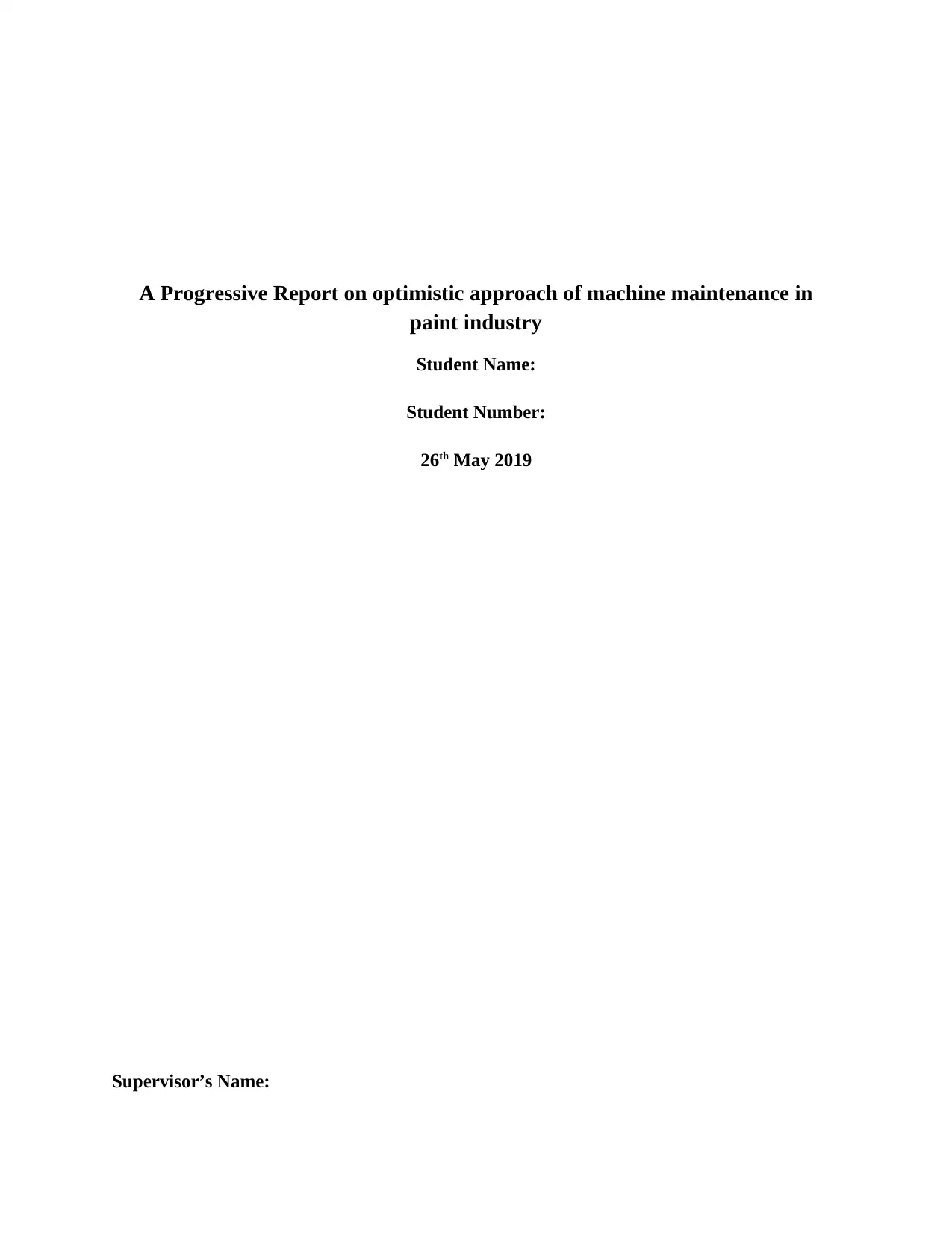
A Progressive Report on optimistic approach of machine maintenance in
paint industry
Student Name:
Student Number:
26th May 2019
Supervisor’s Name:
paint industry
Student Name:
Student Number:
26th May 2019
Supervisor’s Name:
Paraphrase This Document
Need a fresh take? Get an instant paraphrase of this document with our AI Paraphraser
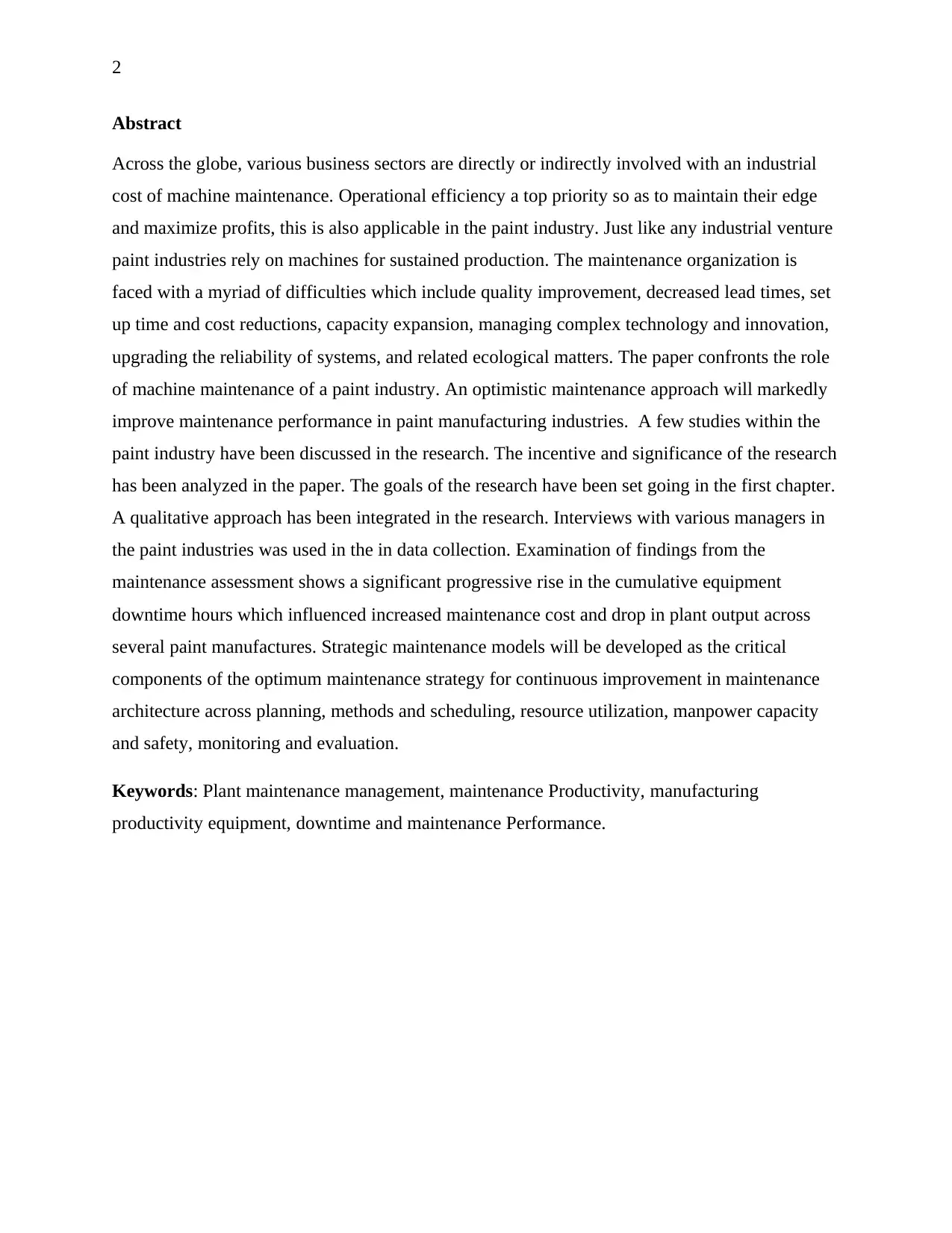
2
Abstract
Across the globe, various business sectors are directly or indirectly involved with an industrial
cost of machine maintenance. Operational efficiency a top priority so as to maintain their edge
and maximize profits, this is also applicable in the paint industry. Just like any industrial venture
paint industries rely on machines for sustained production. The maintenance organization is
faced with a myriad of difficulties which include quality improvement, decreased lead times, set
up time and cost reductions, capacity expansion, managing complex technology and innovation,
upgrading the reliability of systems, and related ecological matters. The paper confronts the role
of machine maintenance of a paint industry. An optimistic maintenance approach will markedly
improve maintenance performance in paint manufacturing industries. A few studies within the
paint industry have been discussed in the research. The incentive and significance of the research
has been analyzed in the paper. The goals of the research have been set going in the first chapter.
A qualitative approach has been integrated in the research. Interviews with various managers in
the paint industries was used in the in data collection. Examination of findings from the
maintenance assessment shows a significant progressive rise in the cumulative equipment
downtime hours which influenced increased maintenance cost and drop in plant output across
several paint manufactures. Strategic maintenance models will be developed as the critical
components of the optimum maintenance strategy for continuous improvement in maintenance
architecture across planning, methods and scheduling, resource utilization, manpower capacity
and safety, monitoring and evaluation.
Keywords: Plant maintenance management, maintenance Productivity, manufacturing
productivity equipment, downtime and maintenance Performance.
Abstract
Across the globe, various business sectors are directly or indirectly involved with an industrial
cost of machine maintenance. Operational efficiency a top priority so as to maintain their edge
and maximize profits, this is also applicable in the paint industry. Just like any industrial venture
paint industries rely on machines for sustained production. The maintenance organization is
faced with a myriad of difficulties which include quality improvement, decreased lead times, set
up time and cost reductions, capacity expansion, managing complex technology and innovation,
upgrading the reliability of systems, and related ecological matters. The paper confronts the role
of machine maintenance of a paint industry. An optimistic maintenance approach will markedly
improve maintenance performance in paint manufacturing industries. A few studies within the
paint industry have been discussed in the research. The incentive and significance of the research
has been analyzed in the paper. The goals of the research have been set going in the first chapter.
A qualitative approach has been integrated in the research. Interviews with various managers in
the paint industries was used in the in data collection. Examination of findings from the
maintenance assessment shows a significant progressive rise in the cumulative equipment
downtime hours which influenced increased maintenance cost and drop in plant output across
several paint manufactures. Strategic maintenance models will be developed as the critical
components of the optimum maintenance strategy for continuous improvement in maintenance
architecture across planning, methods and scheduling, resource utilization, manpower capacity
and safety, monitoring and evaluation.
Keywords: Plant maintenance management, maintenance Productivity, manufacturing
productivity equipment, downtime and maintenance Performance.
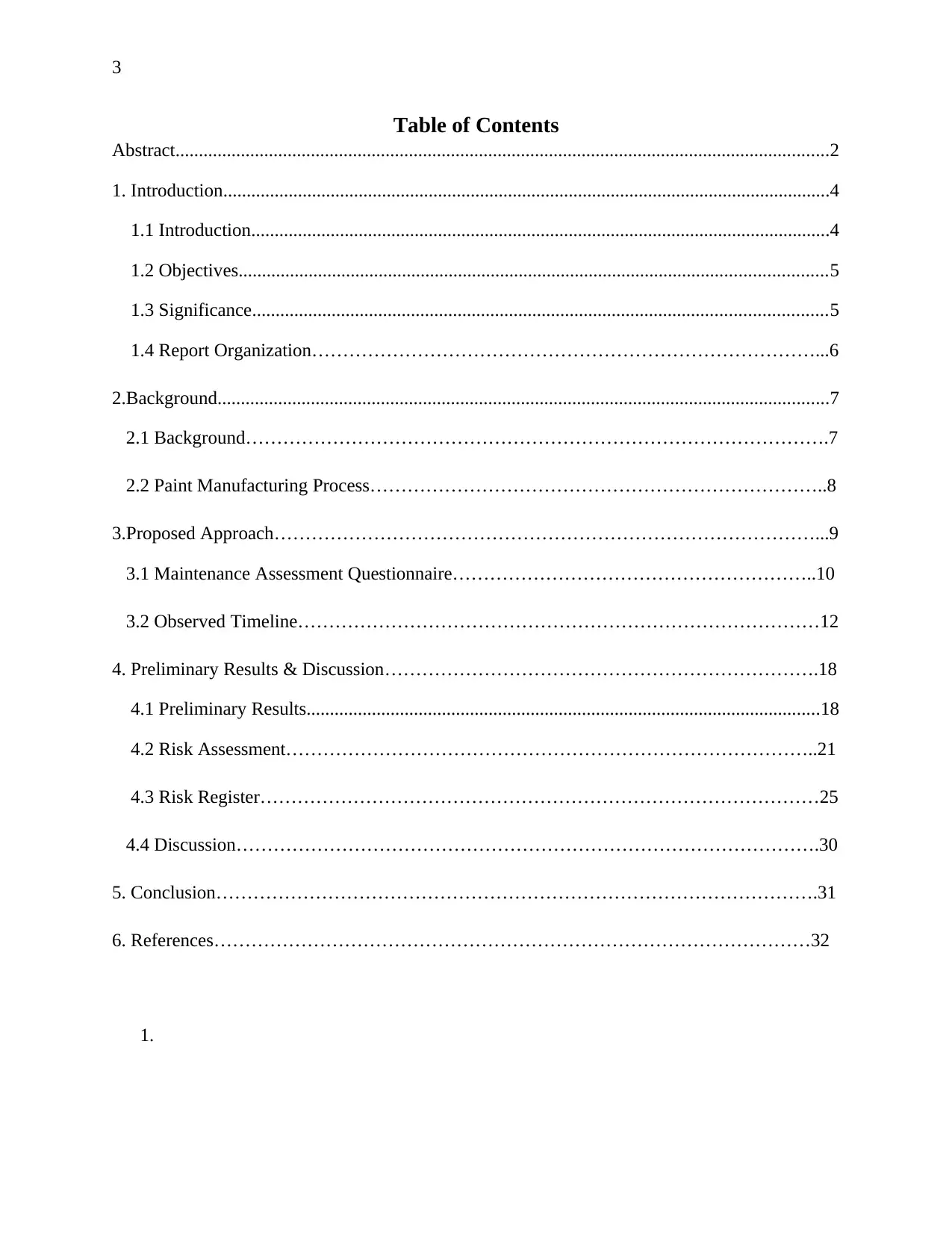
3
Table of Contents
Abstract............................................................................................................................................2
1. Introduction..................................................................................................................................4
1.1 Introduction............................................................................................................................4
1.2 Objectives..............................................................................................................................5
1.3 Significance...........................................................................................................................5
1.4 Report Organization………………………………………………………………………...6
2.Background...................................................................................................................................7
2.1 Background………………………………………………………………………………….7
2.2 Paint Manufacturing Process………………………………………………………………..8
3.Proposed Approach……………………………………………………………………………...9
3.1 Maintenance Assessment Questionnaire…………………………………………………..10
3.2 Observed Timeline…………………………………………………………………………12
4. Preliminary Results & Discussion…………………………………………………………….18
4.1 Preliminary Results..............................................................................................................18
4.2 Risk Assessment…………………………………………………………………………..21
4.3 Risk Register………………………………………………………………………………25
4.4 Discussion………………………………………………………………………………….30
5. Conclusion…………………………………………………………………………………….31
6. References……………………………………………………………………………………32
1.
Table of Contents
Abstract............................................................................................................................................2
1. Introduction..................................................................................................................................4
1.1 Introduction............................................................................................................................4
1.2 Objectives..............................................................................................................................5
1.3 Significance...........................................................................................................................5
1.4 Report Organization………………………………………………………………………...6
2.Background...................................................................................................................................7
2.1 Background………………………………………………………………………………….7
2.2 Paint Manufacturing Process………………………………………………………………..8
3.Proposed Approach……………………………………………………………………………...9
3.1 Maintenance Assessment Questionnaire…………………………………………………..10
3.2 Observed Timeline…………………………………………………………………………12
4. Preliminary Results & Discussion…………………………………………………………….18
4.1 Preliminary Results..............................................................................................................18
4.2 Risk Assessment…………………………………………………………………………..21
4.3 Risk Register………………………………………………………………………………25
4.4 Discussion………………………………………………………………………………….30
5. Conclusion…………………………………………………………………………………….31
6. References……………………………………………………………………………………32
1.
⊘ This is a preview!⊘
Do you want full access?
Subscribe today to unlock all pages.

Trusted by 1+ million students worldwide
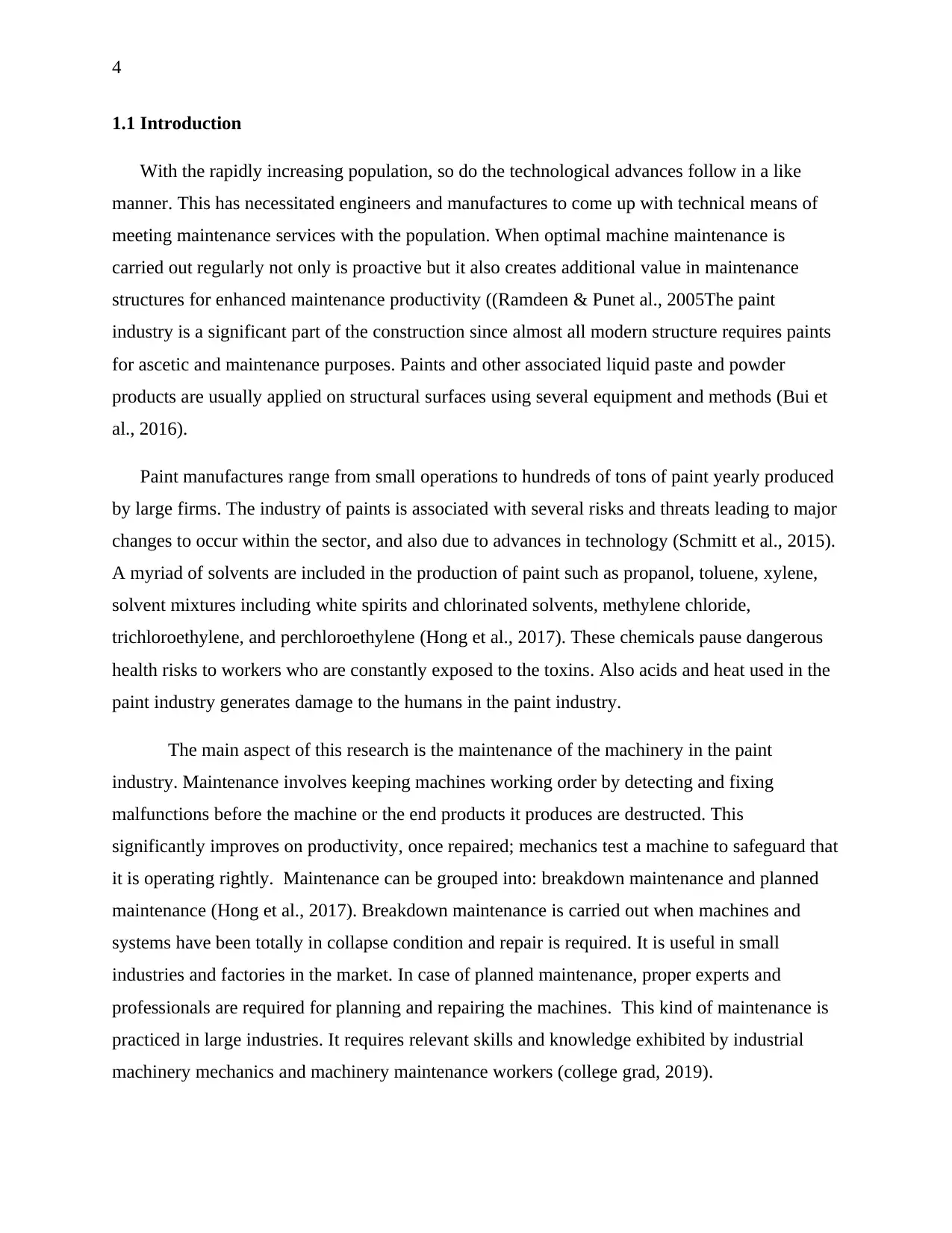
4
1.1 Introduction
With the rapidly increasing population, so do the technological advances follow in a like
manner. This has necessitated engineers and manufactures to come up with technical means of
meeting maintenance services with the population. When optimal machine maintenance is
carried out regularly not only is proactive but it also creates additional value in maintenance
structures for enhanced maintenance productivity ((Ramdeen & Punet al., 2005The paint
industry is a significant part of the construction since almost all modern structure requires paints
for ascetic and maintenance purposes. Paints and other associated liquid paste and powder
products are usually applied on structural surfaces using several equipment and methods (Bui et
al., 2016).
Paint manufactures range from small operations to hundreds of tons of paint yearly produced
by large firms. The industry of paints is associated with several risks and threats leading to major
changes to occur within the sector, and also due to advances in technology (Schmitt et al., 2015).
A myriad of solvents are included in the production of paint such as propanol, toluene, xylene,
solvent mixtures including white spirits and chlorinated solvents, methylene chloride,
trichloroethylene, and perchloroethylene (Hong et al., 2017). These chemicals pause dangerous
health risks to workers who are constantly exposed to the toxins. Also acids and heat used in the
paint industry generates damage to the humans in the paint industry.
The main aspect of this research is the maintenance of the machinery in the paint
industry. Maintenance involves keeping machines working order by detecting and fixing
malfunctions before the machine or the end products it produces are destructed. This
significantly improves on productivity, once repaired; mechanics test a machine to safeguard that
it is operating rightly. Maintenance can be grouped into: breakdown maintenance and planned
maintenance (Hong et al., 2017). Breakdown maintenance is carried out when machines and
systems have been totally in collapse condition and repair is required. It is useful in small
industries and factories in the market. In case of planned maintenance, proper experts and
professionals are required for planning and repairing the machines. This kind of maintenance is
practiced in large industries. It requires relevant skills and knowledge exhibited by industrial
machinery mechanics and machinery maintenance workers (college grad, 2019).
1.1 Introduction
With the rapidly increasing population, so do the technological advances follow in a like
manner. This has necessitated engineers and manufactures to come up with technical means of
meeting maintenance services with the population. When optimal machine maintenance is
carried out regularly not only is proactive but it also creates additional value in maintenance
structures for enhanced maintenance productivity ((Ramdeen & Punet al., 2005The paint
industry is a significant part of the construction since almost all modern structure requires paints
for ascetic and maintenance purposes. Paints and other associated liquid paste and powder
products are usually applied on structural surfaces using several equipment and methods (Bui et
al., 2016).
Paint manufactures range from small operations to hundreds of tons of paint yearly produced
by large firms. The industry of paints is associated with several risks and threats leading to major
changes to occur within the sector, and also due to advances in technology (Schmitt et al., 2015).
A myriad of solvents are included in the production of paint such as propanol, toluene, xylene,
solvent mixtures including white spirits and chlorinated solvents, methylene chloride,
trichloroethylene, and perchloroethylene (Hong et al., 2017). These chemicals pause dangerous
health risks to workers who are constantly exposed to the toxins. Also acids and heat used in the
paint industry generates damage to the humans in the paint industry.
The main aspect of this research is the maintenance of the machinery in the paint
industry. Maintenance involves keeping machines working order by detecting and fixing
malfunctions before the machine or the end products it produces are destructed. This
significantly improves on productivity, once repaired; mechanics test a machine to safeguard that
it is operating rightly. Maintenance can be grouped into: breakdown maintenance and planned
maintenance (Hong et al., 2017). Breakdown maintenance is carried out when machines and
systems have been totally in collapse condition and repair is required. It is useful in small
industries and factories in the market. In case of planned maintenance, proper experts and
professionals are required for planning and repairing the machines. This kind of maintenance is
practiced in large industries. It requires relevant skills and knowledge exhibited by industrial
machinery mechanics and machinery maintenance workers (college grad, 2019).
Paraphrase This Document
Need a fresh take? Get an instant paraphrase of this document with our AI Paraphraser
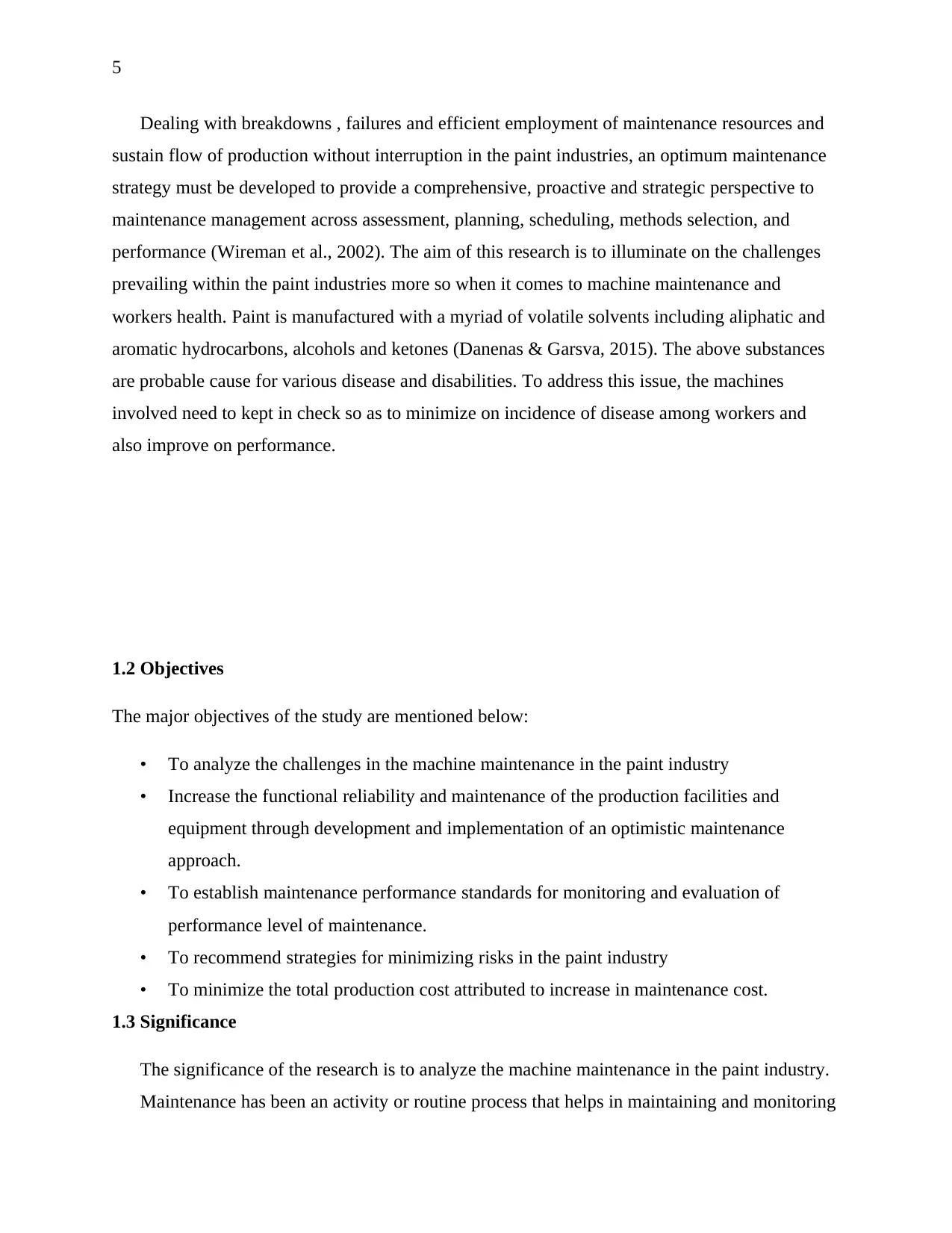
5
Dealing with breakdowns , failures and efficient employment of maintenance resources and
sustain flow of production without interruption in the paint industries, an optimum maintenance
strategy must be developed to provide a comprehensive, proactive and strategic perspective to
maintenance management across assessment, planning, scheduling, methods selection, and
performance (Wireman et al., 2002). The aim of this research is to illuminate on the challenges
prevailing within the paint industries more so when it comes to machine maintenance and
workers health. Paint is manufactured with a myriad of volatile solvents including aliphatic and
aromatic hydrocarbons, alcohols and ketones (Danenas & Garsva, 2015). The above substances
are probable cause for various disease and disabilities. To address this issue, the machines
involved need to kept in check so as to minimize on incidence of disease among workers and
also improve on performance.
1.2 Objectives
The major objectives of the study are mentioned below:
• To analyze the challenges in the machine maintenance in the paint industry
• Increase the functional reliability and maintenance of the production facilities and
equipment through development and implementation of an optimistic maintenance
approach.
• To establish maintenance performance standards for monitoring and evaluation of
performance level of maintenance.
• To recommend strategies for minimizing risks in the paint industry
• To minimize the total production cost attributed to increase in maintenance cost.
1.3 Significance
The significance of the research is to analyze the machine maintenance in the paint industry.
Maintenance has been an activity or routine process that helps in maintaining and monitoring
Dealing with breakdowns , failures and efficient employment of maintenance resources and
sustain flow of production without interruption in the paint industries, an optimum maintenance
strategy must be developed to provide a comprehensive, proactive and strategic perspective to
maintenance management across assessment, planning, scheduling, methods selection, and
performance (Wireman et al., 2002). The aim of this research is to illuminate on the challenges
prevailing within the paint industries more so when it comes to machine maintenance and
workers health. Paint is manufactured with a myriad of volatile solvents including aliphatic and
aromatic hydrocarbons, alcohols and ketones (Danenas & Garsva, 2015). The above substances
are probable cause for various disease and disabilities. To address this issue, the machines
involved need to kept in check so as to minimize on incidence of disease among workers and
also improve on performance.
1.2 Objectives
The major objectives of the study are mentioned below:
• To analyze the challenges in the machine maintenance in the paint industry
• Increase the functional reliability and maintenance of the production facilities and
equipment through development and implementation of an optimistic maintenance
approach.
• To establish maintenance performance standards for monitoring and evaluation of
performance level of maintenance.
• To recommend strategies for minimizing risks in the paint industry
• To minimize the total production cost attributed to increase in maintenance cost.
1.3 Significance
The significance of the research is to analyze the machine maintenance in the paint industry.
Maintenance has been an activity or routine process that helps in maintaining and monitoring
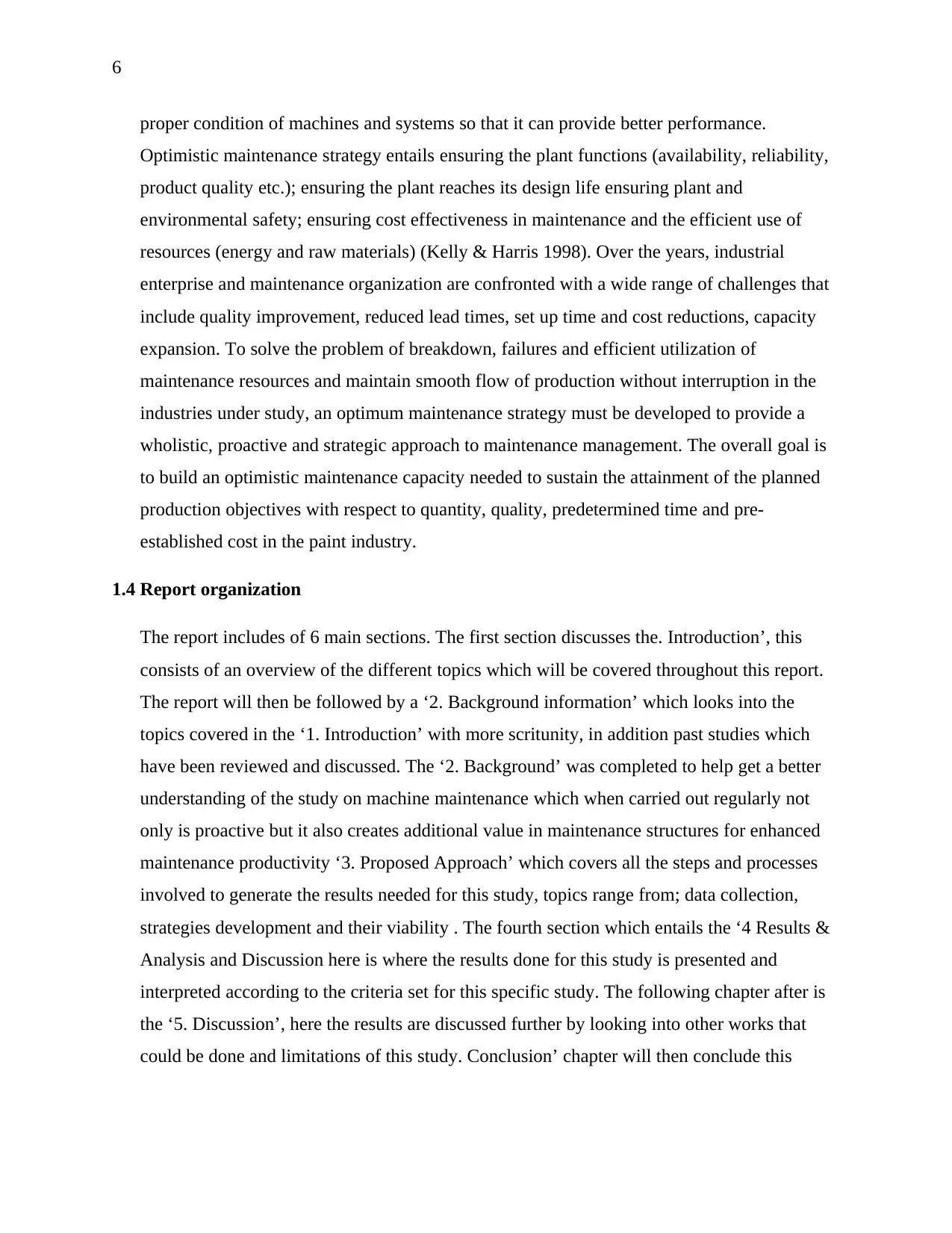
6
proper condition of machines and systems so that it can provide better performance.
Optimistic maintenance strategy entails ensuring the plant functions (availability, reliability,
product quality etc.); ensuring the plant reaches its design life ensuring plant and
environmental safety; ensuring cost effectiveness in maintenance and the efficient use of
resources (energy and raw materials) (Kelly & Harris 1998). Over the years, industrial
enterprise and maintenance organization are confronted with a wide range of challenges that
include quality improvement, reduced lead times, set up time and cost reductions, capacity
expansion. To solve the problem of breakdown, failures and efficient utilization of
maintenance resources and maintain smooth flow of production without interruption in the
industries under study, an optimum maintenance strategy must be developed to provide a
wholistic, proactive and strategic approach to maintenance management. The overall goal is
to build an optimistic maintenance capacity needed to sustain the attainment of the planned
production objectives with respect to quantity, quality, predetermined time and pre-
established cost in the paint industry.
1.4 Report organization
The report includes of 6 main sections. The first section discusses the. Introduction’, this
consists of an overview of the different topics which will be covered throughout this report.
The report will then be followed by a ‘2. Background information’ which looks into the
topics covered in the ‘1. Introduction’ with more scritunity, in addition past studies which
have been reviewed and discussed. The ‘2. Background’ was completed to help get a better
understanding of the study on machine maintenance which when carried out regularly not
only is proactive but it also creates additional value in maintenance structures for enhanced
maintenance productivity ‘3. Proposed Approach’ which covers all the steps and processes
involved to generate the results needed for this study, topics range from; data collection,
strategies development and their viability . The fourth section which entails the ‘4 Results &
Analysis and Discussion here is where the results done for this study is presented and
interpreted according to the criteria set for this specific study. The following chapter after is
the ‘5. Discussion’, here the results are discussed further by looking into other works that
could be done and limitations of this study. Conclusion’ chapter will then conclude this
proper condition of machines and systems so that it can provide better performance.
Optimistic maintenance strategy entails ensuring the plant functions (availability, reliability,
product quality etc.); ensuring the plant reaches its design life ensuring plant and
environmental safety; ensuring cost effectiveness in maintenance and the efficient use of
resources (energy and raw materials) (Kelly & Harris 1998). Over the years, industrial
enterprise and maintenance organization are confronted with a wide range of challenges that
include quality improvement, reduced lead times, set up time and cost reductions, capacity
expansion. To solve the problem of breakdown, failures and efficient utilization of
maintenance resources and maintain smooth flow of production without interruption in the
industries under study, an optimum maintenance strategy must be developed to provide a
wholistic, proactive and strategic approach to maintenance management. The overall goal is
to build an optimistic maintenance capacity needed to sustain the attainment of the planned
production objectives with respect to quantity, quality, predetermined time and pre-
established cost in the paint industry.
1.4 Report organization
The report includes of 6 main sections. The first section discusses the. Introduction’, this
consists of an overview of the different topics which will be covered throughout this report.
The report will then be followed by a ‘2. Background information’ which looks into the
topics covered in the ‘1. Introduction’ with more scritunity, in addition past studies which
have been reviewed and discussed. The ‘2. Background’ was completed to help get a better
understanding of the study on machine maintenance which when carried out regularly not
only is proactive but it also creates additional value in maintenance structures for enhanced
maintenance productivity ‘3. Proposed Approach’ which covers all the steps and processes
involved to generate the results needed for this study, topics range from; data collection,
strategies development and their viability . The fourth section which entails the ‘4 Results &
Analysis and Discussion here is where the results done for this study is presented and
interpreted according to the criteria set for this specific study. The following chapter after is
the ‘5. Discussion’, here the results are discussed further by looking into other works that
could be done and limitations of this study. Conclusion’ chapter will then conclude this
⊘ This is a preview!⊘
Do you want full access?
Subscribe today to unlock all pages.

Trusted by 1+ million students worldwide
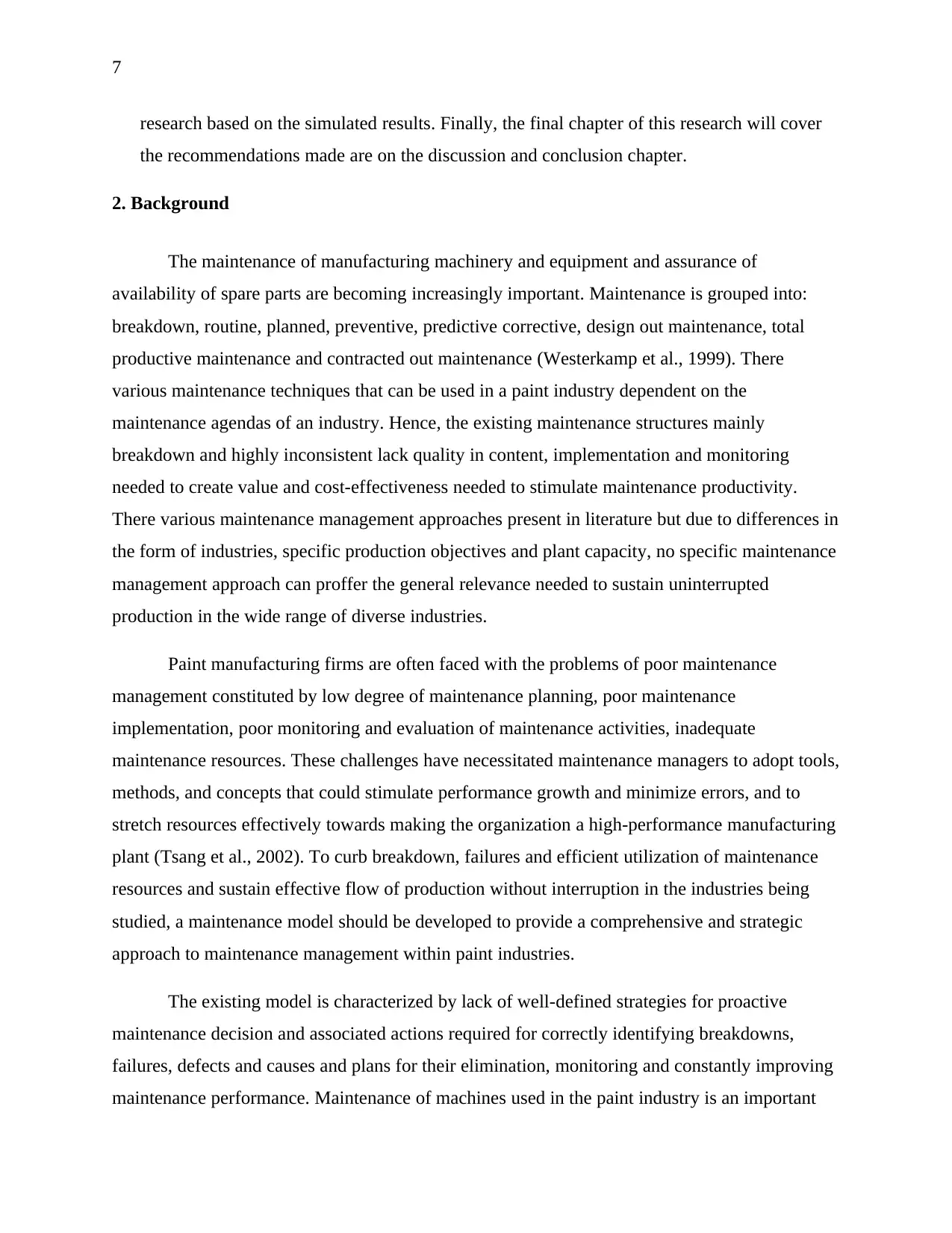
7
research based on the simulated results. Finally, the final chapter of this research will cover
the recommendations made are on the discussion and conclusion chapter.
2. Background
The maintenance of manufacturing machinery and equipment and assurance of
availability of spare parts are becoming increasingly important. Maintenance is grouped into:
breakdown, routine, planned, preventive, predictive corrective, design out maintenance, total
productive maintenance and contracted out maintenance (Westerkamp et al., 1999). There
various maintenance techniques that can be used in a paint industry dependent on the
maintenance agendas of an industry. Hence, the existing maintenance structures mainly
breakdown and highly inconsistent lack quality in content, implementation and monitoring
needed to create value and cost-effectiveness needed to stimulate maintenance productivity.
There various maintenance management approaches present in literature but due to differences in
the form of industries, specific production objectives and plant capacity, no specific maintenance
management approach can proffer the general relevance needed to sustain uninterrupted
production in the wide range of diverse industries.
Paint manufacturing firms are often faced with the problems of poor maintenance
management constituted by low degree of maintenance planning, poor maintenance
implementation, poor monitoring and evaluation of maintenance activities, inadequate
maintenance resources. These challenges have necessitated maintenance managers to adopt tools,
methods, and concepts that could stimulate performance growth and minimize errors, and to
stretch resources effectively towards making the organization a high-performance manufacturing
plant (Tsang et al., 2002). To curb breakdown, failures and efficient utilization of maintenance
resources and sustain effective flow of production without interruption in the industries being
studied, a maintenance model should be developed to provide a comprehensive and strategic
approach to maintenance management within paint industries.
The existing model is characterized by lack of well-defined strategies for proactive
maintenance decision and associated actions required for correctly identifying breakdowns,
failures, defects and causes and plans for their elimination, monitoring and constantly improving
maintenance performance. Maintenance of machines used in the paint industry is an important
research based on the simulated results. Finally, the final chapter of this research will cover
the recommendations made are on the discussion and conclusion chapter.
2. Background
The maintenance of manufacturing machinery and equipment and assurance of
availability of spare parts are becoming increasingly important. Maintenance is grouped into:
breakdown, routine, planned, preventive, predictive corrective, design out maintenance, total
productive maintenance and contracted out maintenance (Westerkamp et al., 1999). There
various maintenance techniques that can be used in a paint industry dependent on the
maintenance agendas of an industry. Hence, the existing maintenance structures mainly
breakdown and highly inconsistent lack quality in content, implementation and monitoring
needed to create value and cost-effectiveness needed to stimulate maintenance productivity.
There various maintenance management approaches present in literature but due to differences in
the form of industries, specific production objectives and plant capacity, no specific maintenance
management approach can proffer the general relevance needed to sustain uninterrupted
production in the wide range of diverse industries.
Paint manufacturing firms are often faced with the problems of poor maintenance
management constituted by low degree of maintenance planning, poor maintenance
implementation, poor monitoring and evaluation of maintenance activities, inadequate
maintenance resources. These challenges have necessitated maintenance managers to adopt tools,
methods, and concepts that could stimulate performance growth and minimize errors, and to
stretch resources effectively towards making the organization a high-performance manufacturing
plant (Tsang et al., 2002). To curb breakdown, failures and efficient utilization of maintenance
resources and sustain effective flow of production without interruption in the industries being
studied, a maintenance model should be developed to provide a comprehensive and strategic
approach to maintenance management within paint industries.
The existing model is characterized by lack of well-defined strategies for proactive
maintenance decision and associated actions required for correctly identifying breakdowns,
failures, defects and causes and plans for their elimination, monitoring and constantly improving
maintenance performance. Maintenance of machines used in the paint industry is an important
Paraphrase This Document
Need a fresh take? Get an instant paraphrase of this document with our AI Paraphraser
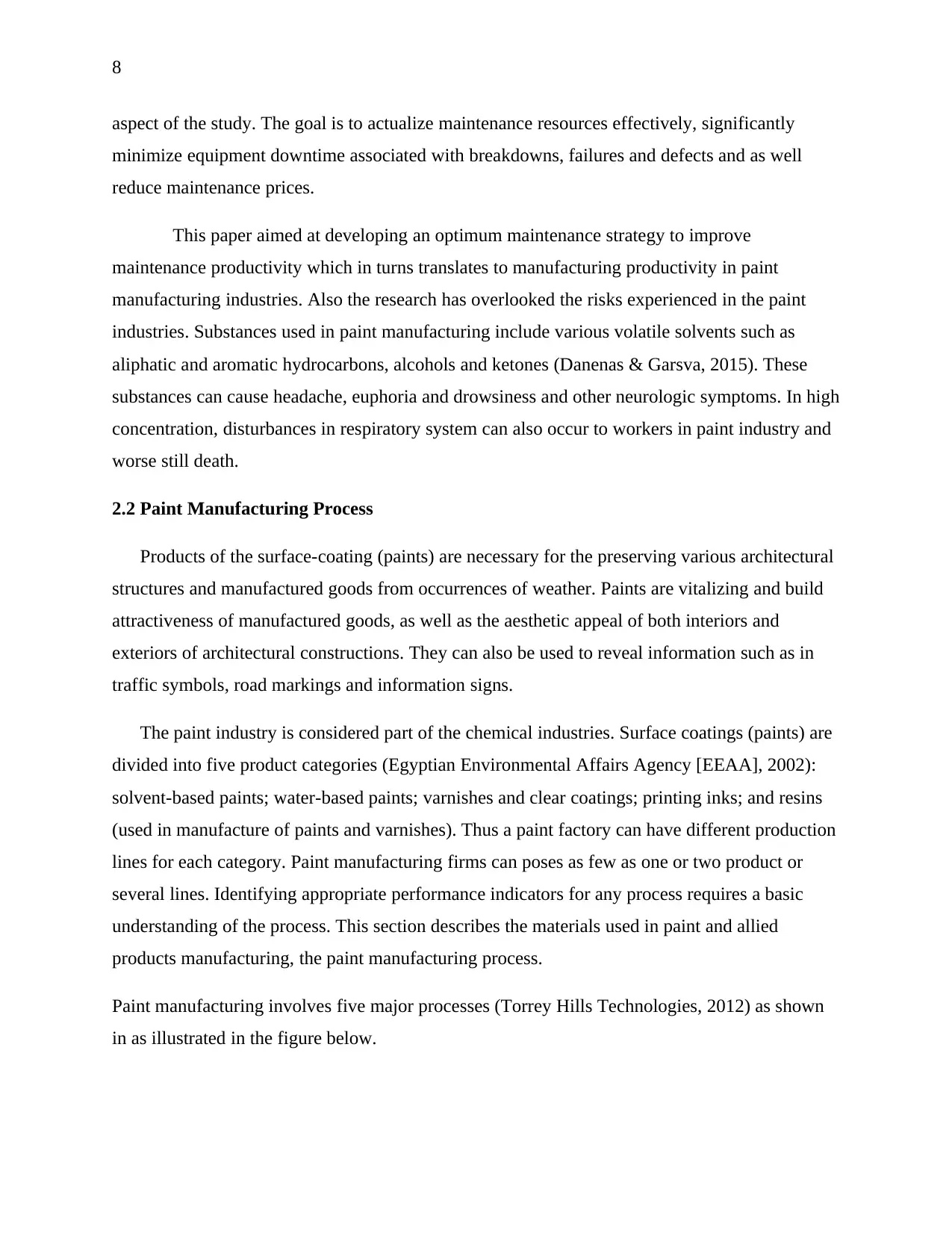
8
aspect of the study. The goal is to actualize maintenance resources effectively, significantly
minimize equipment downtime associated with breakdowns, failures and defects and as well
reduce maintenance prices.
This paper aimed at developing an optimum maintenance strategy to improve
maintenance productivity which in turns translates to manufacturing productivity in paint
manufacturing industries. Also the research has overlooked the risks experienced in the paint
industries. Substances used in paint manufacturing include various volatile solvents such as
aliphatic and aromatic hydrocarbons, alcohols and ketones (Danenas & Garsva, 2015). These
substances can cause headache, euphoria and drowsiness and other neurologic symptoms. In high
concentration, disturbances in respiratory system can also occur to workers in paint industry and
worse still death.
2.2 Paint Manufacturing Process
Products of the surface-coating (paints) are necessary for the preserving various architectural
structures and manufactured goods from occurrences of weather. Paints are vitalizing and build
attractiveness of manufactured goods, as well as the aesthetic appeal of both interiors and
exteriors of architectural constructions. They can also be used to reveal information such as in
traffic symbols, road markings and information signs.
The paint industry is considered part of the chemical industries. Surface coatings (paints) are
divided into five product categories (Egyptian Environmental Affairs Agency [EEAA], 2002):
solvent-based paints; water-based paints; varnishes and clear coatings; printing inks; and resins
(used in manufacture of paints and varnishes). Thus a paint factory can have different production
lines for each category. Paint manufacturing firms can poses as few as one or two product or
several lines. Identifying appropriate performance indicators for any process requires a basic
understanding of the process. This section describes the materials used in paint and allied
products manufacturing, the paint manufacturing process.
Paint manufacturing involves five major processes (Torrey Hills Technologies, 2012) as shown
in as illustrated in the figure below.
aspect of the study. The goal is to actualize maintenance resources effectively, significantly
minimize equipment downtime associated with breakdowns, failures and defects and as well
reduce maintenance prices.
This paper aimed at developing an optimum maintenance strategy to improve
maintenance productivity which in turns translates to manufacturing productivity in paint
manufacturing industries. Also the research has overlooked the risks experienced in the paint
industries. Substances used in paint manufacturing include various volatile solvents such as
aliphatic and aromatic hydrocarbons, alcohols and ketones (Danenas & Garsva, 2015). These
substances can cause headache, euphoria and drowsiness and other neurologic symptoms. In high
concentration, disturbances in respiratory system can also occur to workers in paint industry and
worse still death.
2.2 Paint Manufacturing Process
Products of the surface-coating (paints) are necessary for the preserving various architectural
structures and manufactured goods from occurrences of weather. Paints are vitalizing and build
attractiveness of manufactured goods, as well as the aesthetic appeal of both interiors and
exteriors of architectural constructions. They can also be used to reveal information such as in
traffic symbols, road markings and information signs.
The paint industry is considered part of the chemical industries. Surface coatings (paints) are
divided into five product categories (Egyptian Environmental Affairs Agency [EEAA], 2002):
solvent-based paints; water-based paints; varnishes and clear coatings; printing inks; and resins
(used in manufacture of paints and varnishes). Thus a paint factory can have different production
lines for each category. Paint manufacturing firms can poses as few as one or two product or
several lines. Identifying appropriate performance indicators for any process requires a basic
understanding of the process. This section describes the materials used in paint and allied
products manufacturing, the paint manufacturing process.
Paint manufacturing involves five major processes (Torrey Hills Technologies, 2012) as shown
in as illustrated in the figure below.
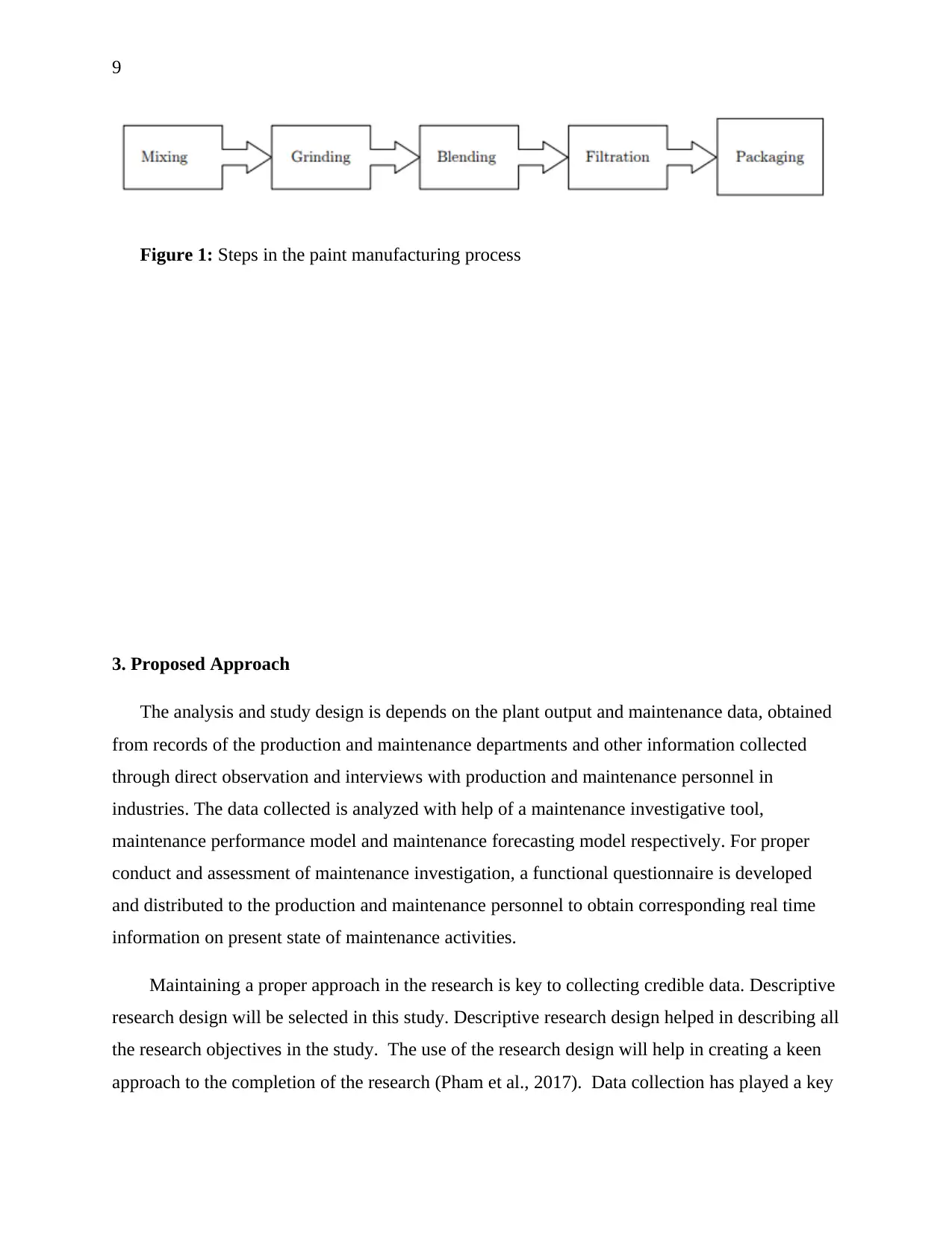
9
Figure 1: Steps in the paint manufacturing process
3. Proposed Approach
The analysis and study design is depends on the plant output and maintenance data, obtained
from records of the production and maintenance departments and other information collected
through direct observation and interviews with production and maintenance personnel in
industries. The data collected is analyzed with help of a maintenance investigative tool,
maintenance performance model and maintenance forecasting model respectively. For proper
conduct and assessment of maintenance investigation, a functional questionnaire is developed
and distributed to the production and maintenance personnel to obtain corresponding real time
information on present state of maintenance activities.
Maintaining a proper approach in the research is key to collecting credible data. Descriptive
research design will be selected in this study. Descriptive research design helped in describing all
the research objectives in the study. The use of the research design will help in creating a keen
approach to the completion of the research (Pham et al., 2017). Data collection has played a key
Figure 1: Steps in the paint manufacturing process
3. Proposed Approach
The analysis and study design is depends on the plant output and maintenance data, obtained
from records of the production and maintenance departments and other information collected
through direct observation and interviews with production and maintenance personnel in
industries. The data collected is analyzed with help of a maintenance investigative tool,
maintenance performance model and maintenance forecasting model respectively. For proper
conduct and assessment of maintenance investigation, a functional questionnaire is developed
and distributed to the production and maintenance personnel to obtain corresponding real time
information on present state of maintenance activities.
Maintaining a proper approach in the research is key to collecting credible data. Descriptive
research design will be selected in this study. Descriptive research design helped in describing all
the research objectives in the study. The use of the research design will help in creating a keen
approach to the completion of the research (Pham et al., 2017). Data collection has played a key
⊘ This is a preview!⊘
Do you want full access?
Subscribe today to unlock all pages.

Trusted by 1+ million students worldwide
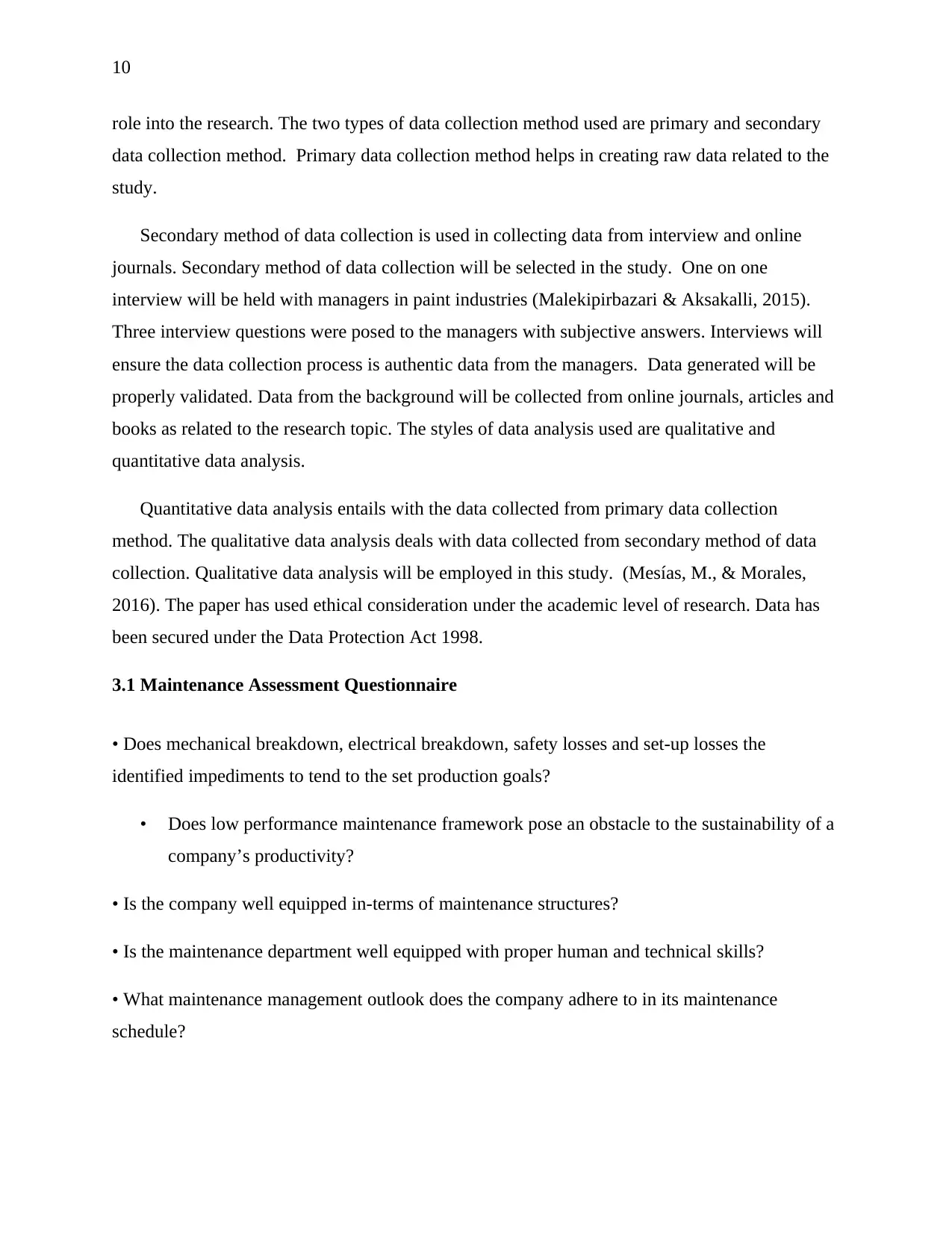
10
role into the research. The two types of data collection method used are primary and secondary
data collection method. Primary data collection method helps in creating raw data related to the
study.
Secondary method of data collection is used in collecting data from interview and online
journals. Secondary method of data collection will be selected in the study. One on one
interview will be held with managers in paint industries (Malekipirbazari & Aksakalli, 2015).
Three interview questions were posed to the managers with subjective answers. Interviews will
ensure the data collection process is authentic data from the managers. Data generated will be
properly validated. Data from the background will be collected from online journals, articles and
books as related to the research topic. The styles of data analysis used are qualitative and
quantitative data analysis.
Quantitative data analysis entails with the data collected from primary data collection
method. The qualitative data analysis deals with data collected from secondary method of data
collection. Qualitative data analysis will be employed in this study. (Mesías, M., & Morales,
2016). The paper has used ethical consideration under the academic level of research. Data has
been secured under the Data Protection Act 1998.
3.1 Maintenance Assessment Questionnaire
• Does mechanical breakdown, electrical breakdown, safety losses and set-up losses the
identified impediments to tend to the set production goals?
• Does low performance maintenance framework pose an obstacle to the sustainability of a
company’s productivity?
• Is the company well equipped in-terms of maintenance structures?
• Is the maintenance department well equipped with proper human and technical skills?
• What maintenance management outlook does the company adhere to in its maintenance
schedule?
role into the research. The two types of data collection method used are primary and secondary
data collection method. Primary data collection method helps in creating raw data related to the
study.
Secondary method of data collection is used in collecting data from interview and online
journals. Secondary method of data collection will be selected in the study. One on one
interview will be held with managers in paint industries (Malekipirbazari & Aksakalli, 2015).
Three interview questions were posed to the managers with subjective answers. Interviews will
ensure the data collection process is authentic data from the managers. Data generated will be
properly validated. Data from the background will be collected from online journals, articles and
books as related to the research topic. The styles of data analysis used are qualitative and
quantitative data analysis.
Quantitative data analysis entails with the data collected from primary data collection
method. The qualitative data analysis deals with data collected from secondary method of data
collection. Qualitative data analysis will be employed in this study. (Mesías, M., & Morales,
2016). The paper has used ethical consideration under the academic level of research. Data has
been secured under the Data Protection Act 1998.
3.1 Maintenance Assessment Questionnaire
• Does mechanical breakdown, electrical breakdown, safety losses and set-up losses the
identified impediments to tend to the set production goals?
• Does low performance maintenance framework pose an obstacle to the sustainability of a
company’s productivity?
• Is the company well equipped in-terms of maintenance structures?
• Is the maintenance department well equipped with proper human and technical skills?
• What maintenance management outlook does the company adhere to in its maintenance
schedule?
Paraphrase This Document
Need a fresh take? Get an instant paraphrase of this document with our AI Paraphraser
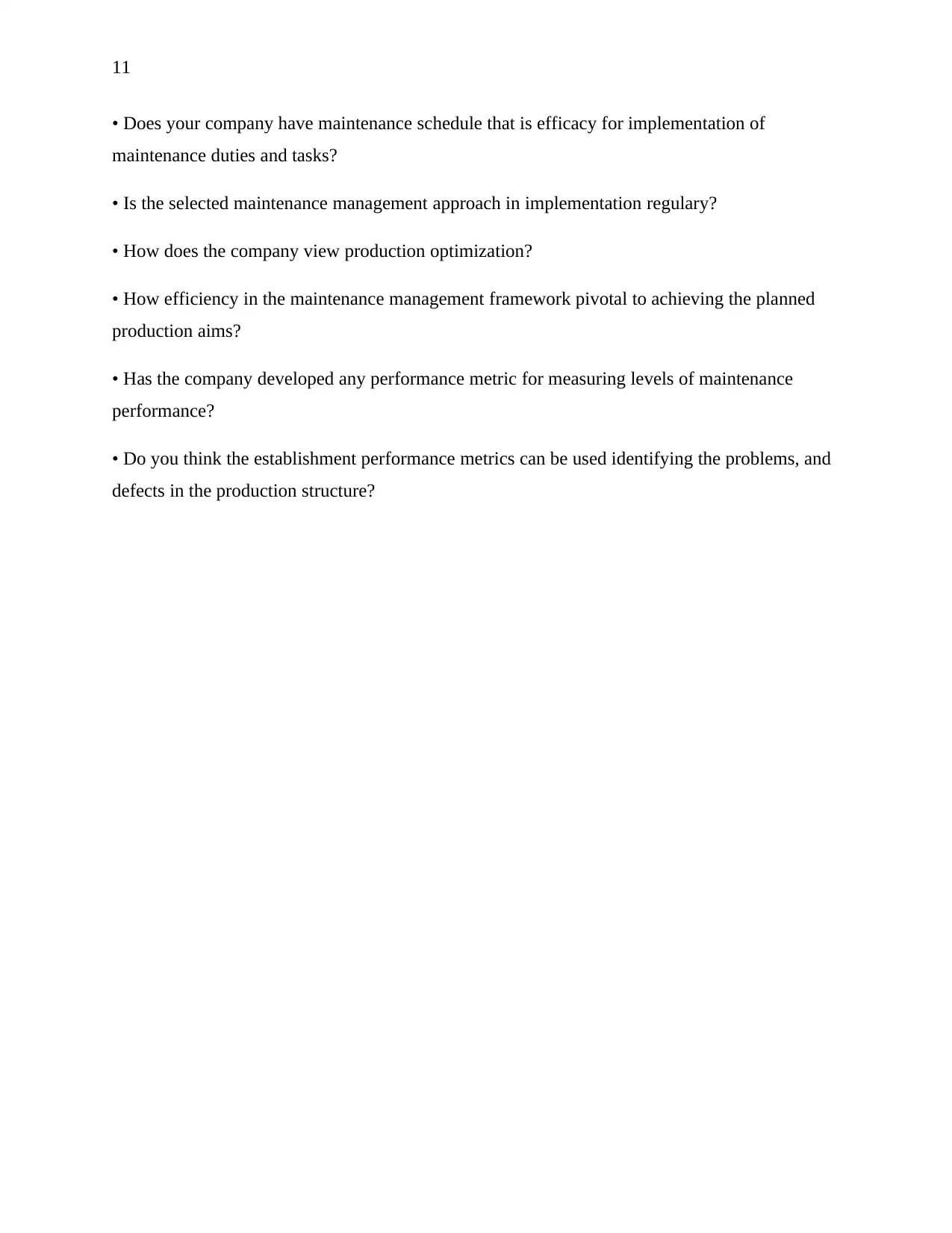
11
• Does your company have maintenance schedule that is efficacy for implementation of
maintenance duties and tasks?
• Is the selected maintenance management approach in implementation regulary?
• How does the company view production optimization?
• How efficiency in the maintenance management framework pivotal to achieving the planned
production aims?
• Has the company developed any performance metric for measuring levels of maintenance
performance?
• Do you think the establishment performance metrics can be used identifying the problems, and
defects in the production structure?
• Does your company have maintenance schedule that is efficacy for implementation of
maintenance duties and tasks?
• Is the selected maintenance management approach in implementation regulary?
• How does the company view production optimization?
• How efficiency in the maintenance management framework pivotal to achieving the planned
production aims?
• Has the company developed any performance metric for measuring levels of maintenance
performance?
• Do you think the establishment performance metrics can be used identifying the problems, and
defects in the production structure?
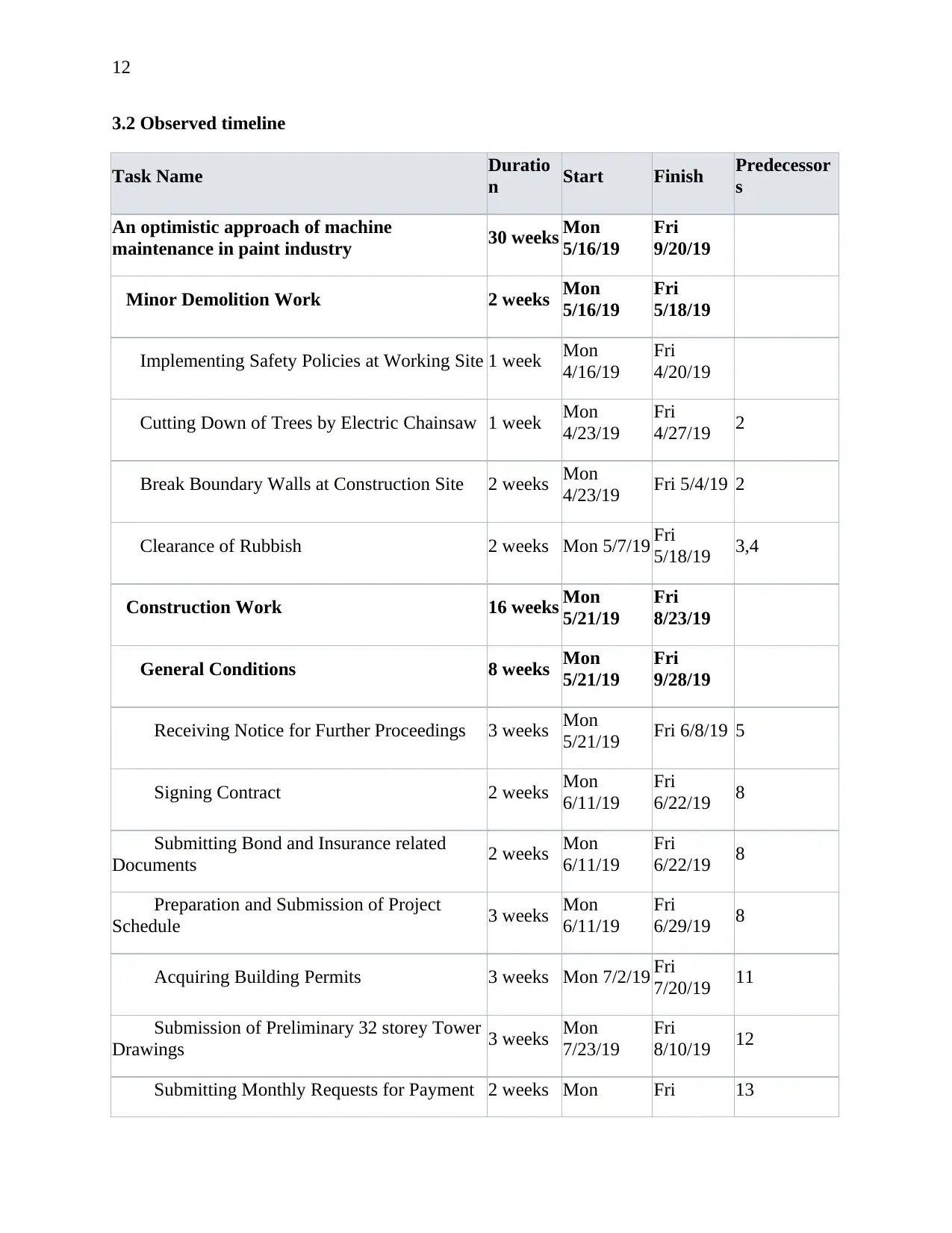
12
3.2 Observed timeline
Task Name Duratio
n Start Finish Predecessor
s
An optimistic approach of machine
maintenance in paint industry 30 weeks Mon
5/16/19
Fri
9/20/19
Minor Demolition Work 2 weeks Mon
5/16/19
Fri
5/18/19
Implementing Safety Policies at Working Site 1 week Mon
4/16/19
Fri
4/20/19
Cutting Down of Trees by Electric Chainsaw 1 week Mon
4/23/19
Fri
4/27/19 2
Break Boundary Walls at Construction Site 2 weeks Mon
4/23/19 Fri 5/4/19 2
Clearance of Rubbish 2 weeks Mon 5/7/19 Fri
5/18/19 3,4
Construction Work 16 weeks Mon
5/21/19
Fri
8/23/19
General Conditions 8 weeks Mon
5/21/19
Fri
9/28/19
Receiving Notice for Further Proceedings 3 weeks Mon
5/21/19 Fri 6/8/19 5
Signing Contract 2 weeks Mon
6/11/19
Fri
6/22/19 8
Submitting Bond and Insurance related
Documents 2 weeks Mon
6/11/19
Fri
6/22/19 8
Preparation and Submission of Project
Schedule 3 weeks Mon
6/11/19
Fri
6/29/19 8
Acquiring Building Permits 3 weeks Mon 7/2/19 Fri
7/20/19 11
Submission of Preliminary 32 storey Tower
Drawings 3 weeks Mon
7/23/19
Fri
8/10/19 12
Submitting Monthly Requests for Payment 2 weeks Mon Fri 13
3.2 Observed timeline
Task Name Duratio
n Start Finish Predecessor
s
An optimistic approach of machine
maintenance in paint industry 30 weeks Mon
5/16/19
Fri
9/20/19
Minor Demolition Work 2 weeks Mon
5/16/19
Fri
5/18/19
Implementing Safety Policies at Working Site 1 week Mon
4/16/19
Fri
4/20/19
Cutting Down of Trees by Electric Chainsaw 1 week Mon
4/23/19
Fri
4/27/19 2
Break Boundary Walls at Construction Site 2 weeks Mon
4/23/19 Fri 5/4/19 2
Clearance of Rubbish 2 weeks Mon 5/7/19 Fri
5/18/19 3,4
Construction Work 16 weeks Mon
5/21/19
Fri
8/23/19
General Conditions 8 weeks Mon
5/21/19
Fri
9/28/19
Receiving Notice for Further Proceedings 3 weeks Mon
5/21/19 Fri 6/8/19 5
Signing Contract 2 weeks Mon
6/11/19
Fri
6/22/19 8
Submitting Bond and Insurance related
Documents 2 weeks Mon
6/11/19
Fri
6/22/19 8
Preparation and Submission of Project
Schedule 3 weeks Mon
6/11/19
Fri
6/29/19 8
Acquiring Building Permits 3 weeks Mon 7/2/19 Fri
7/20/19 11
Submission of Preliminary 32 storey Tower
Drawings 3 weeks Mon
7/23/19
Fri
8/10/19 12
Submitting Monthly Requests for Payment 2 weeks Mon Fri 13
⊘ This is a preview!⊘
Do you want full access?
Subscribe today to unlock all pages.

Trusted by 1+ million students worldwide
1 out of 36
Related Documents
Your All-in-One AI-Powered Toolkit for Academic Success.
+13062052269
info@desklib.com
Available 24*7 on WhatsApp / Email
![[object Object]](/_next/static/media/star-bottom.7253800d.svg)
Unlock your academic potential
Copyright © 2020–2025 A2Z Services. All Rights Reserved. Developed and managed by ZUCOL.





